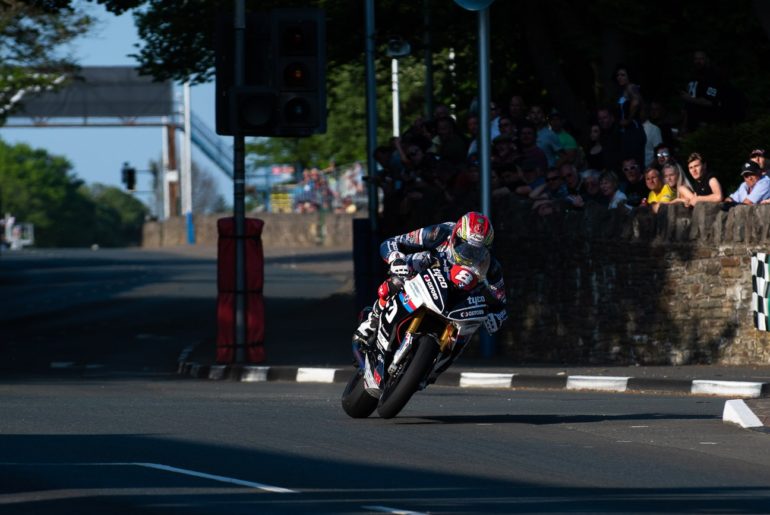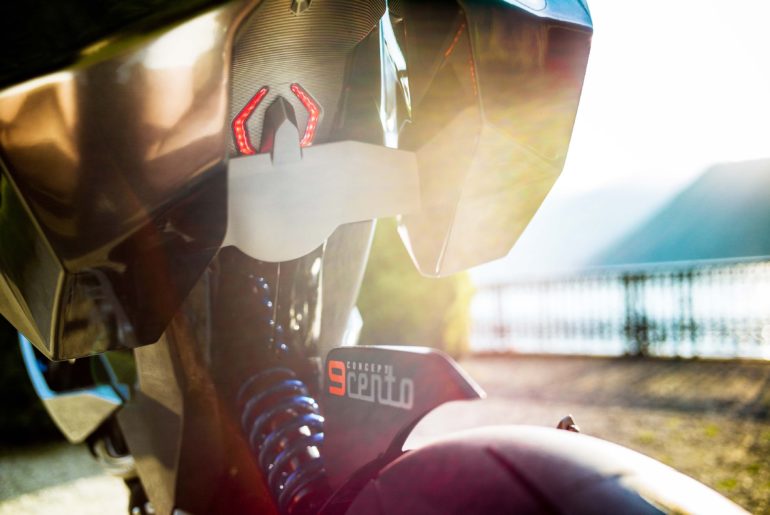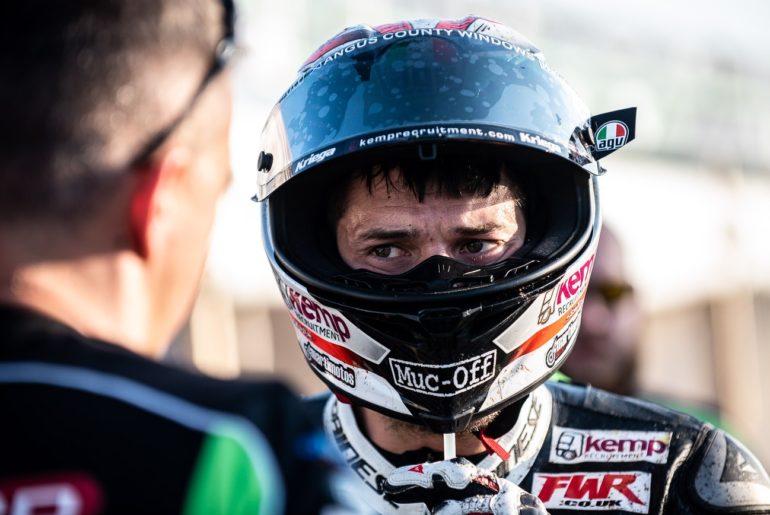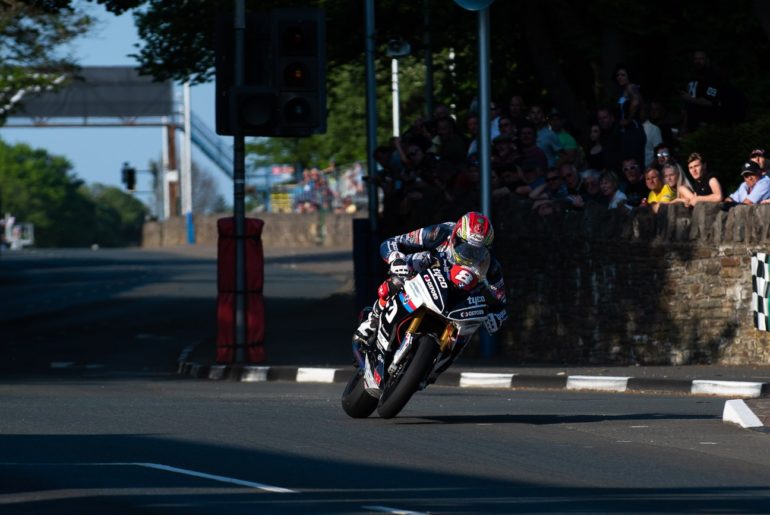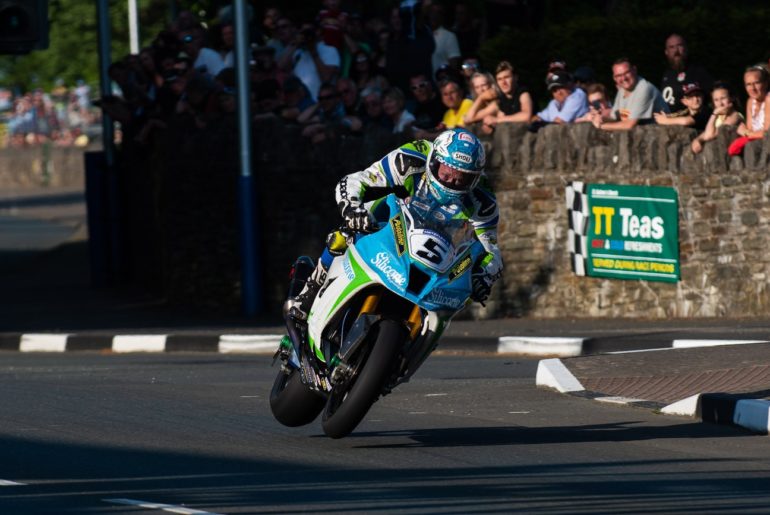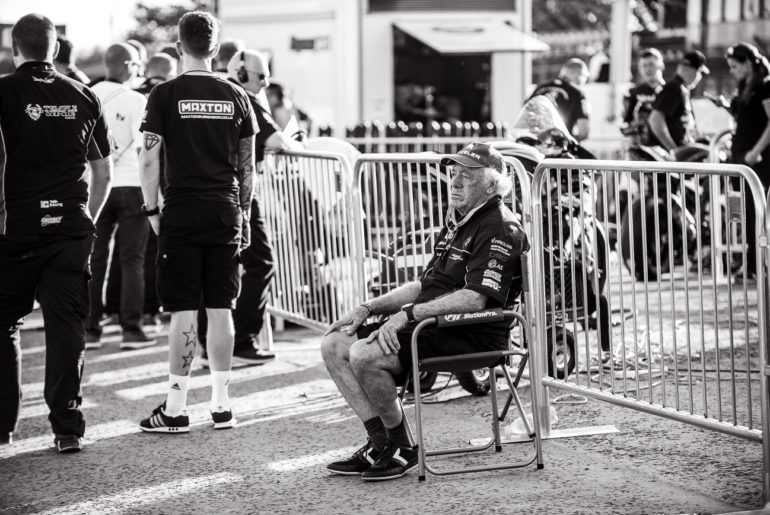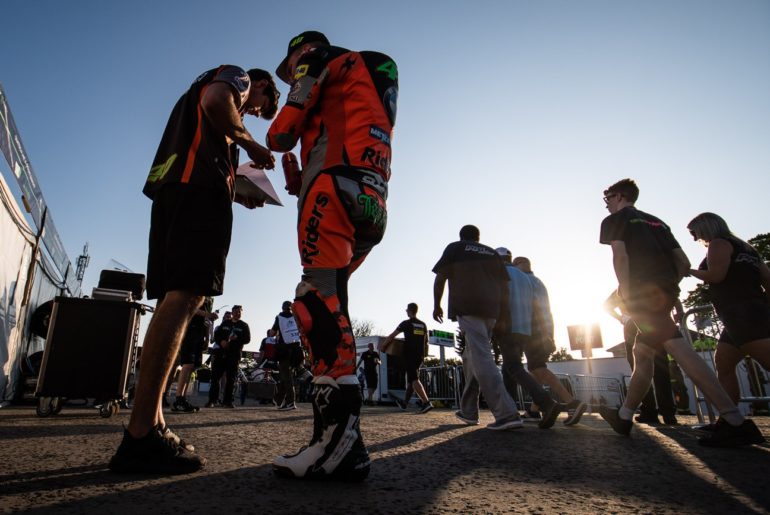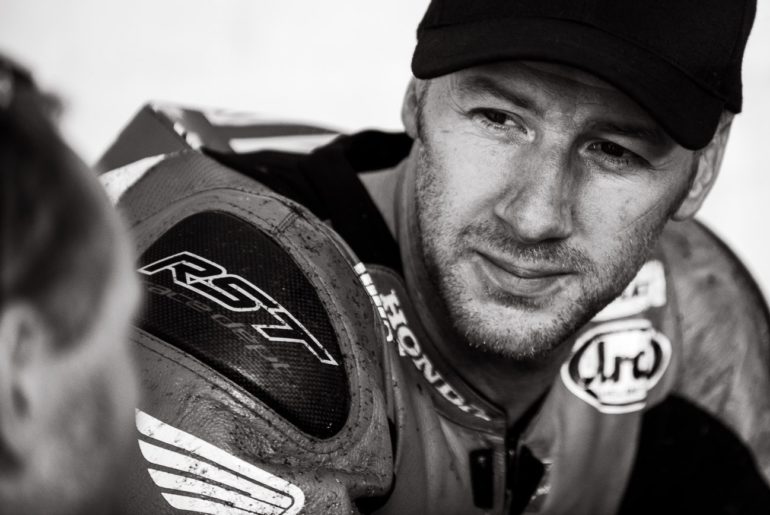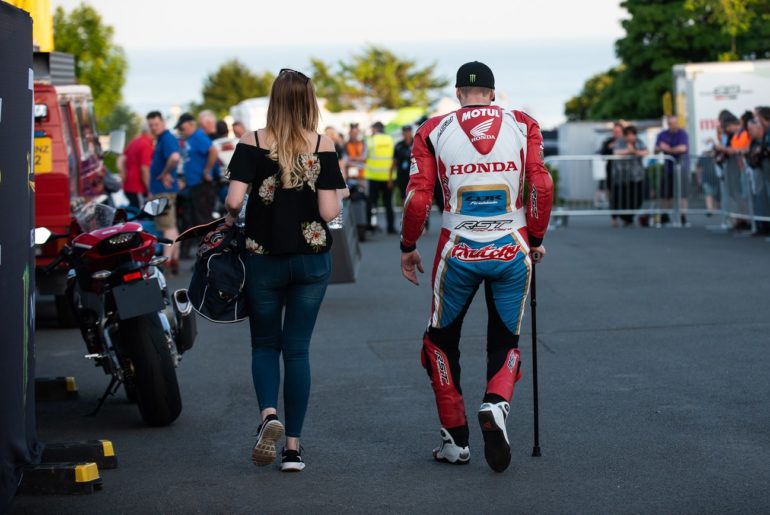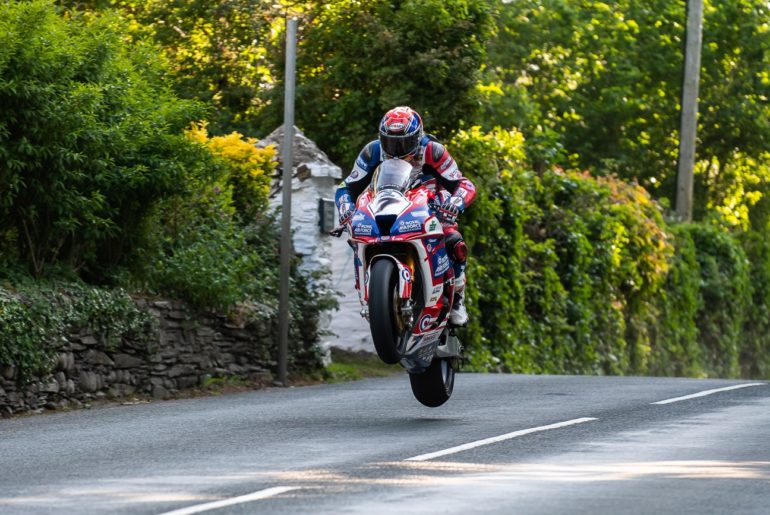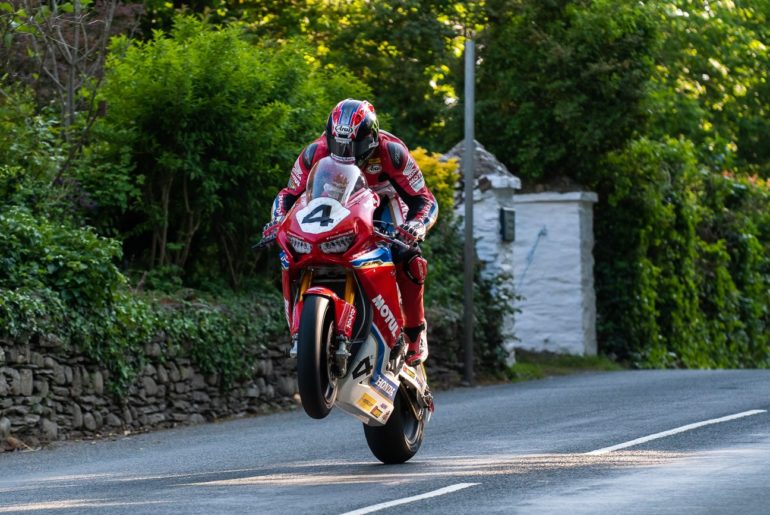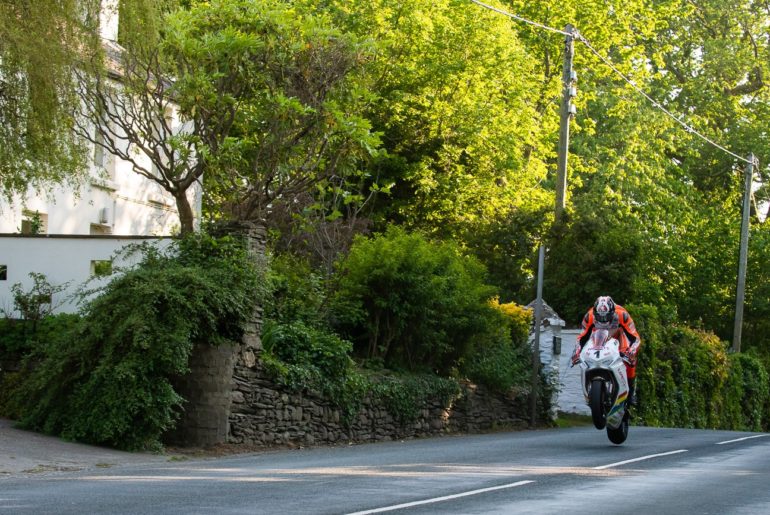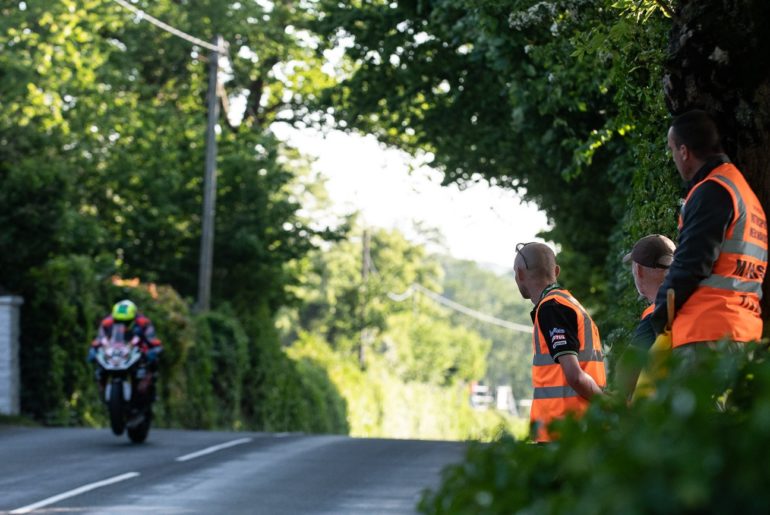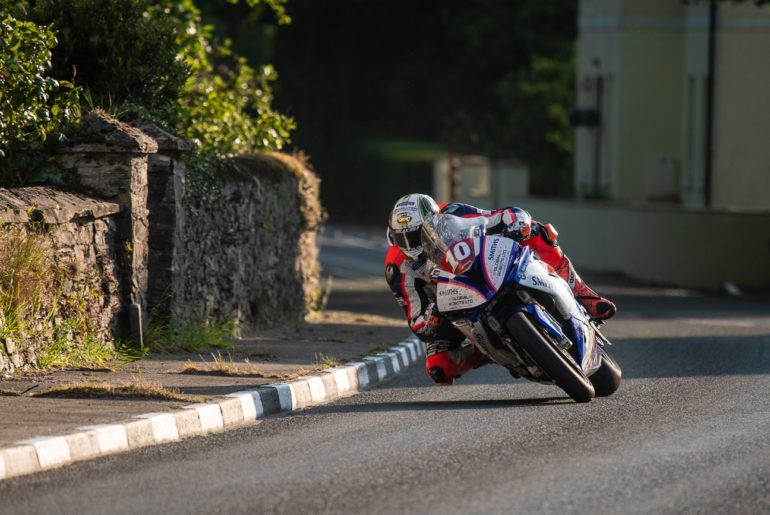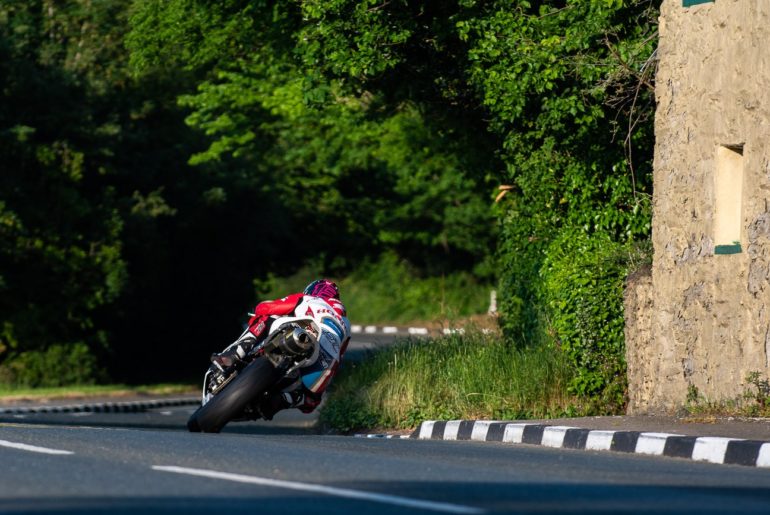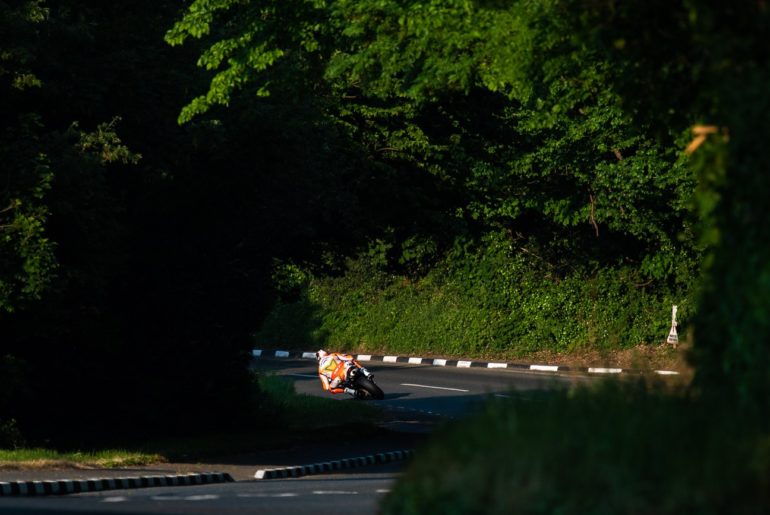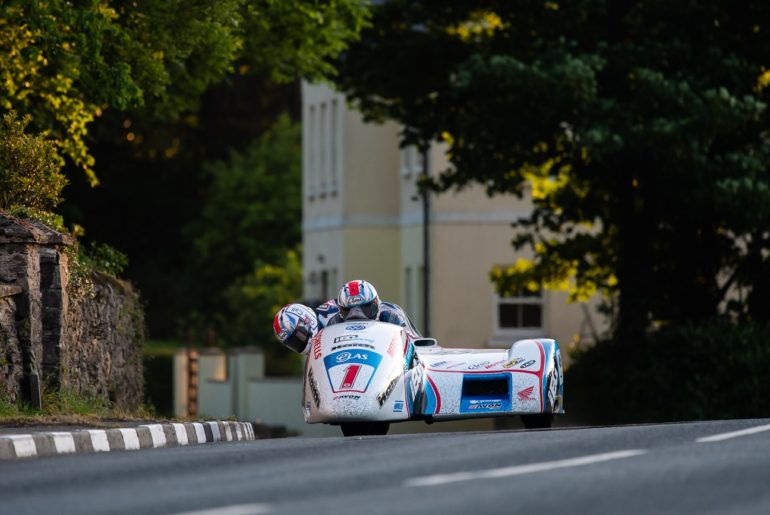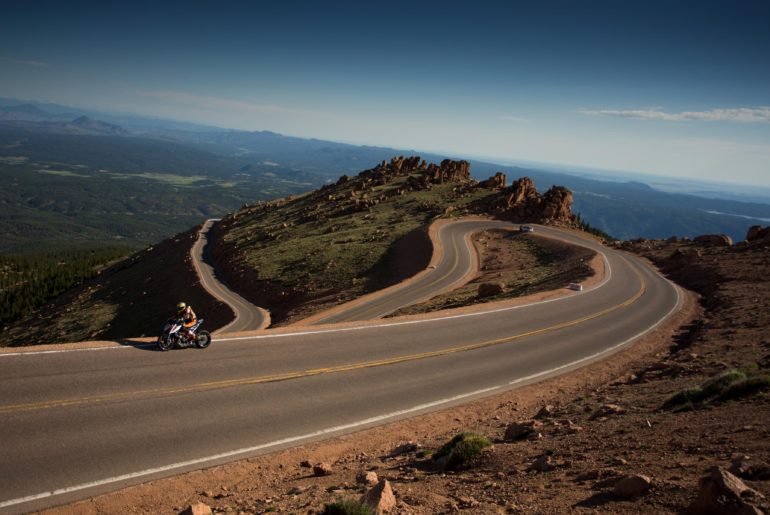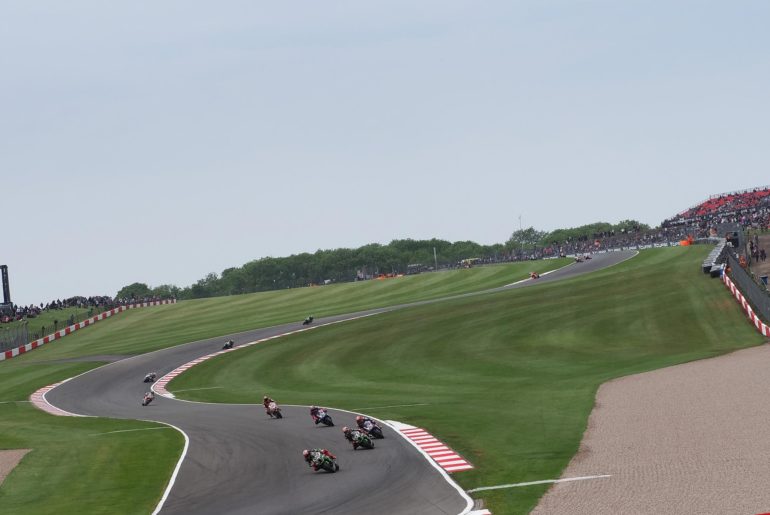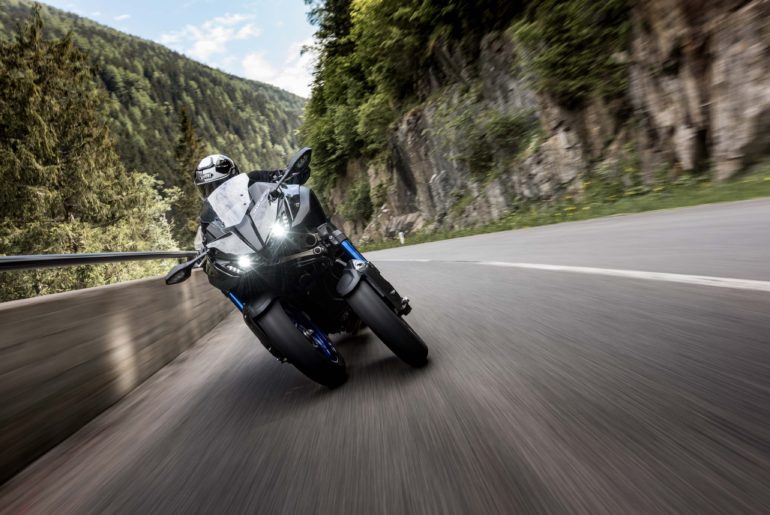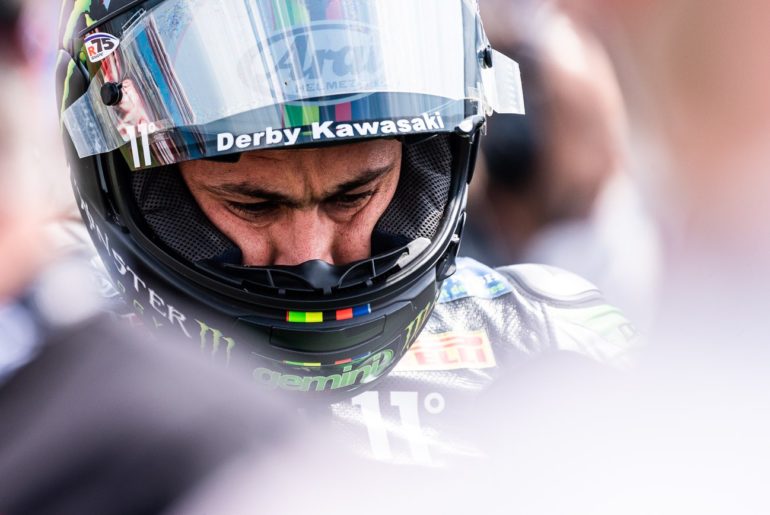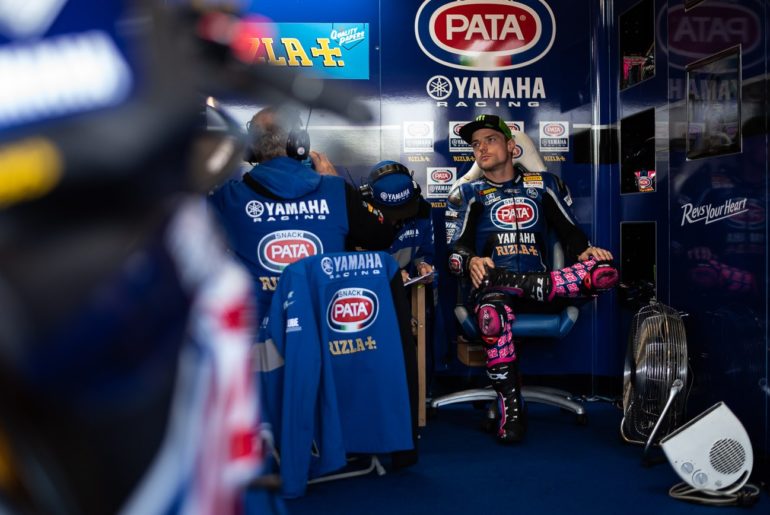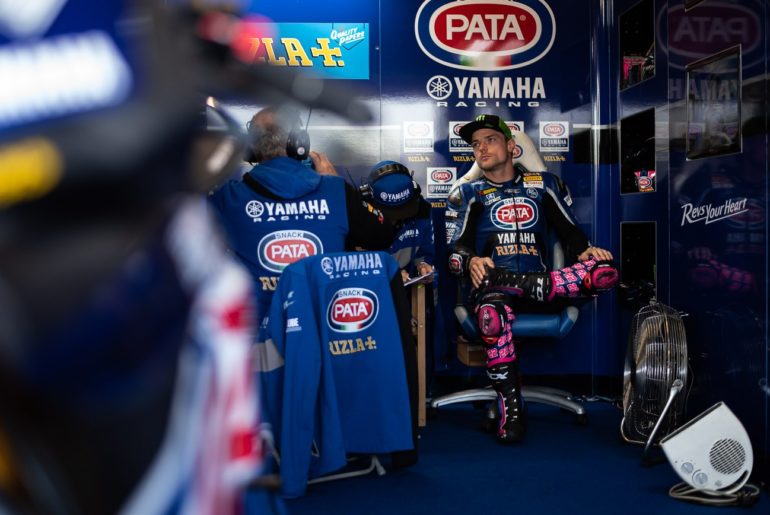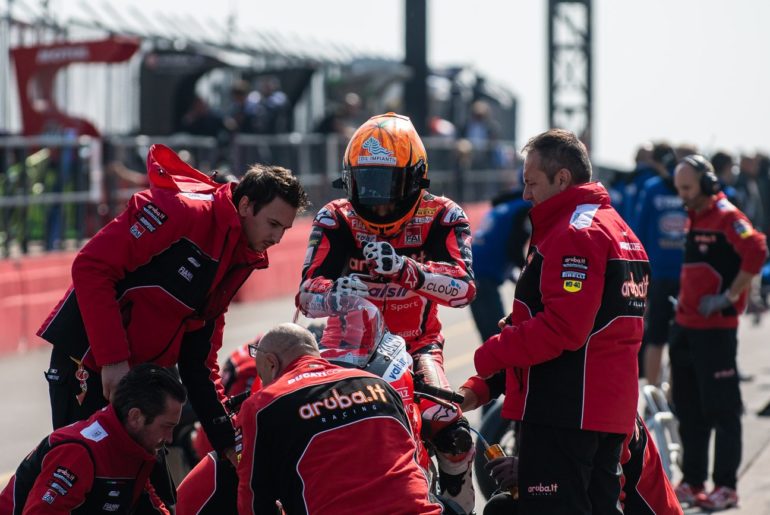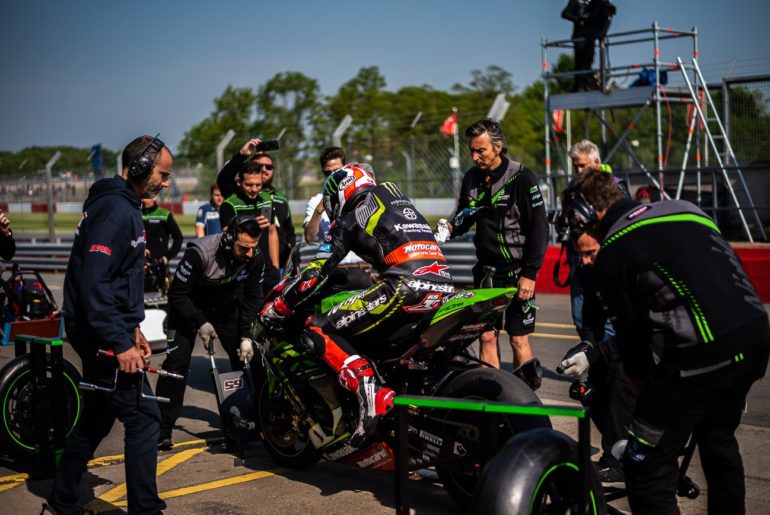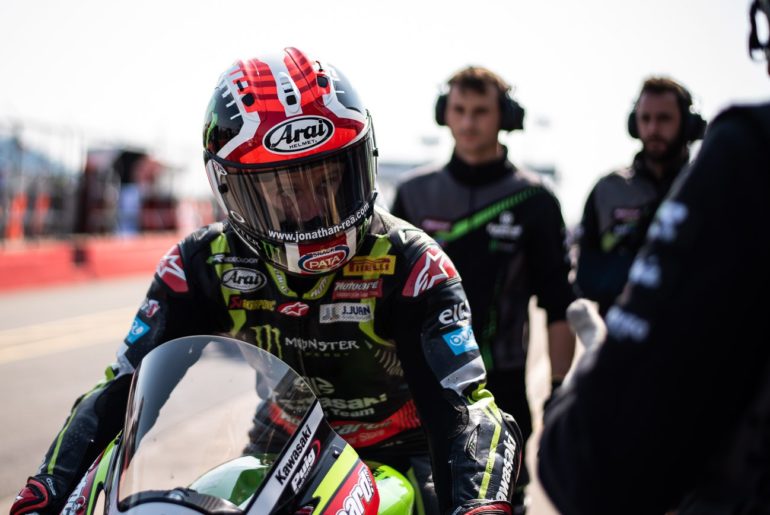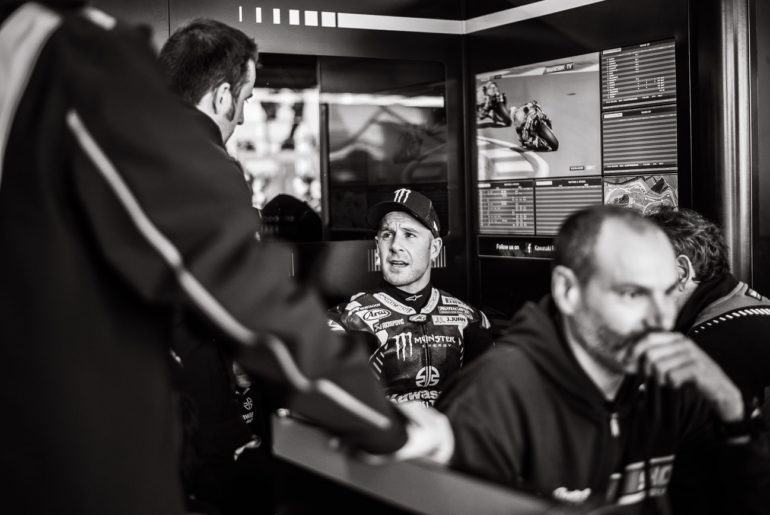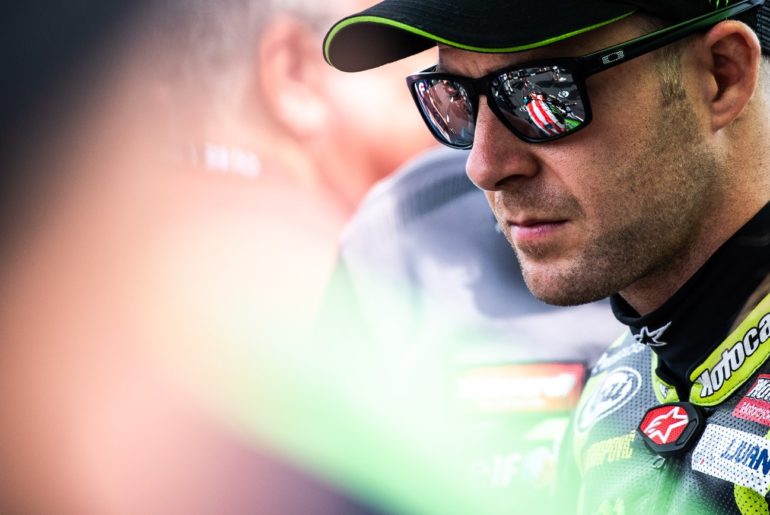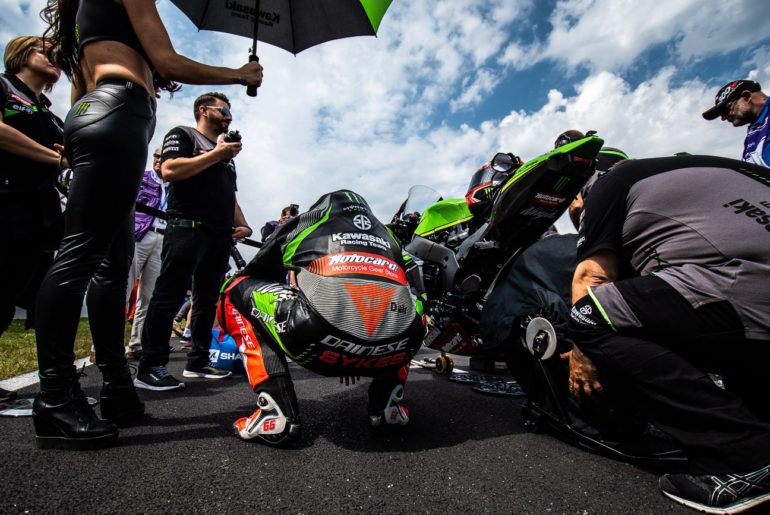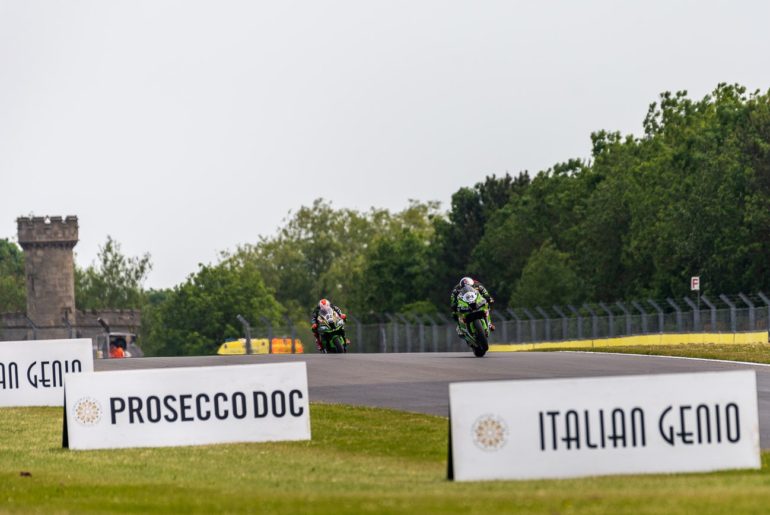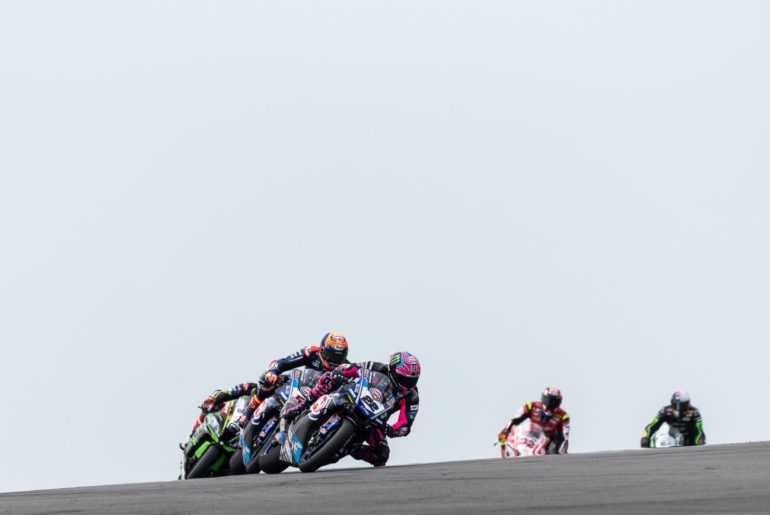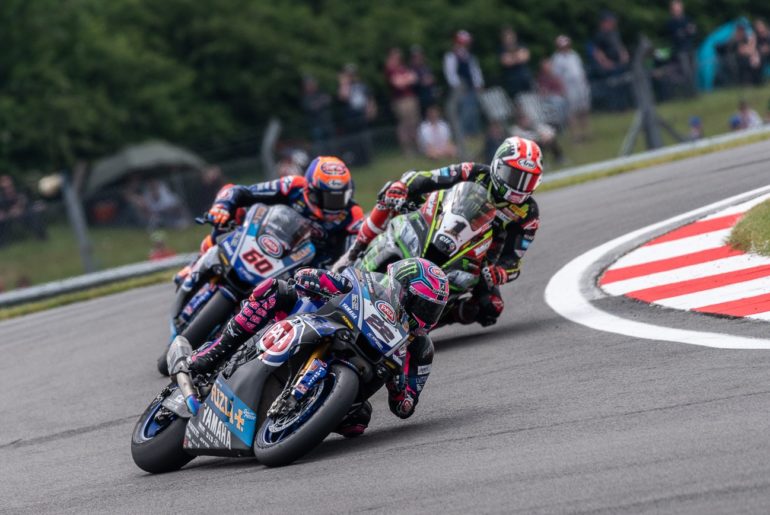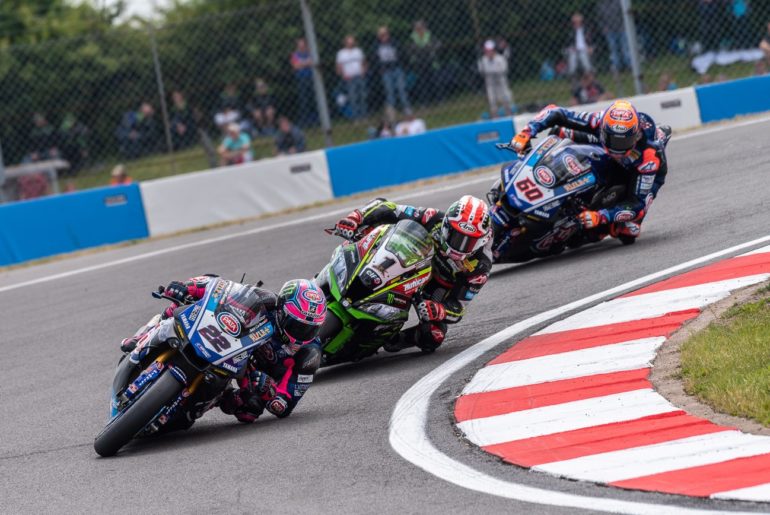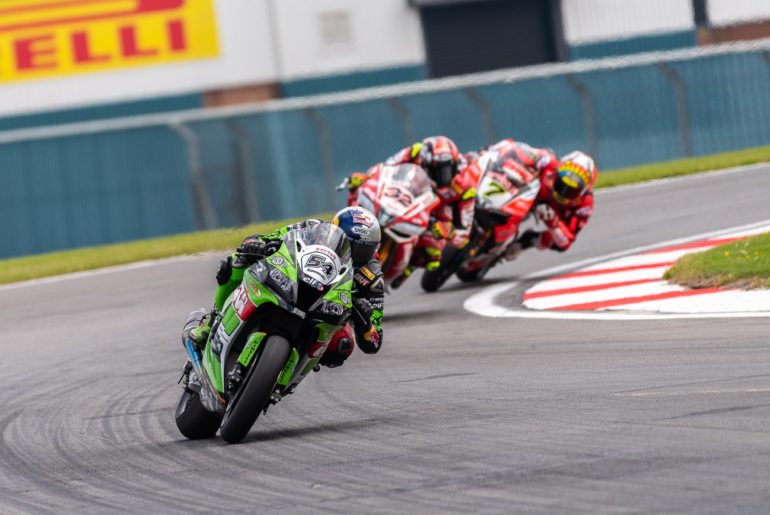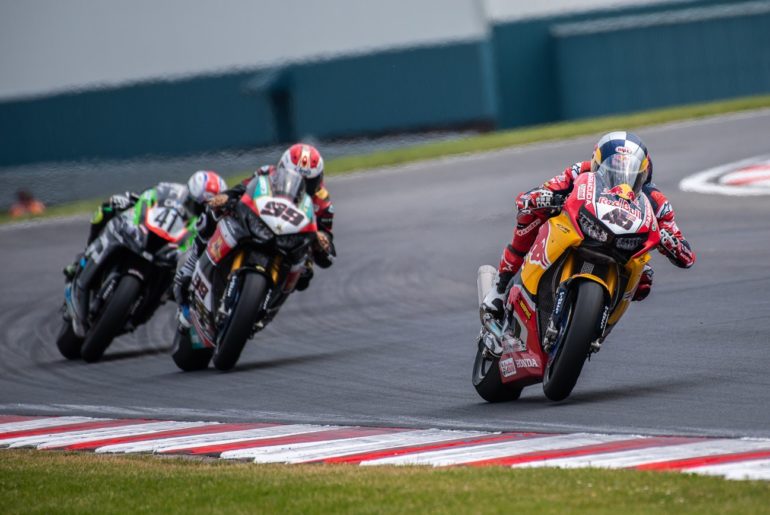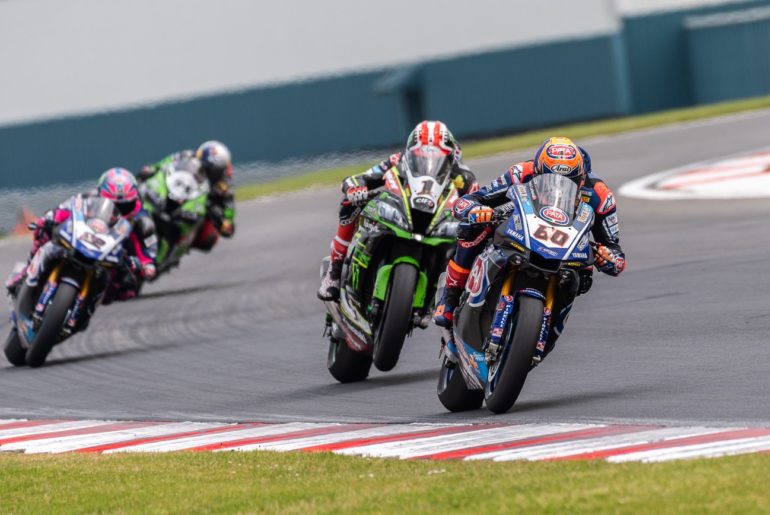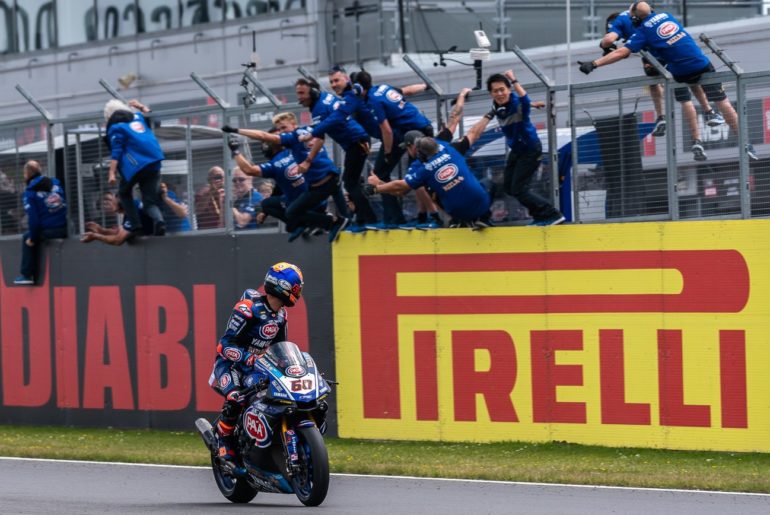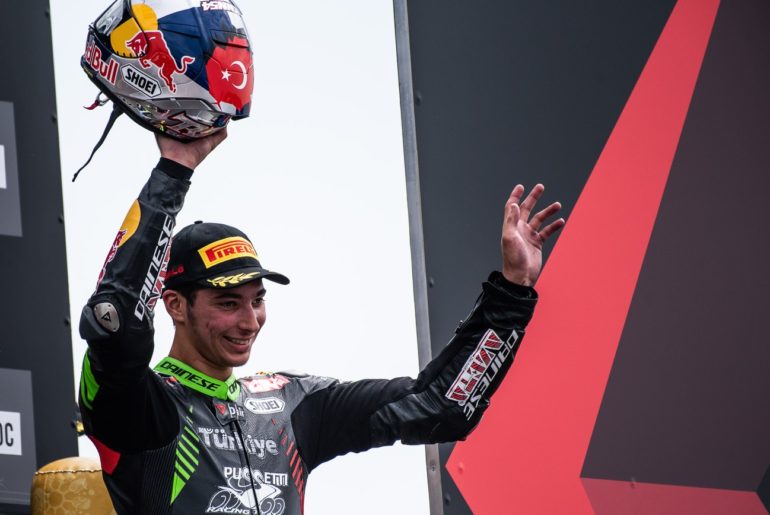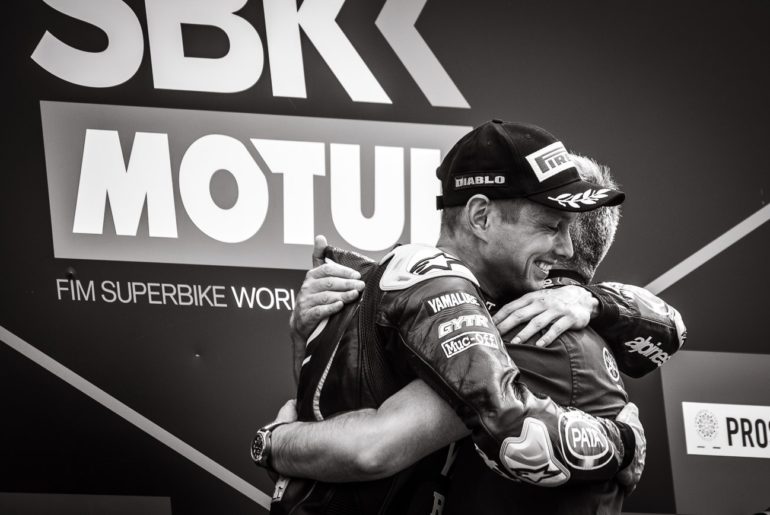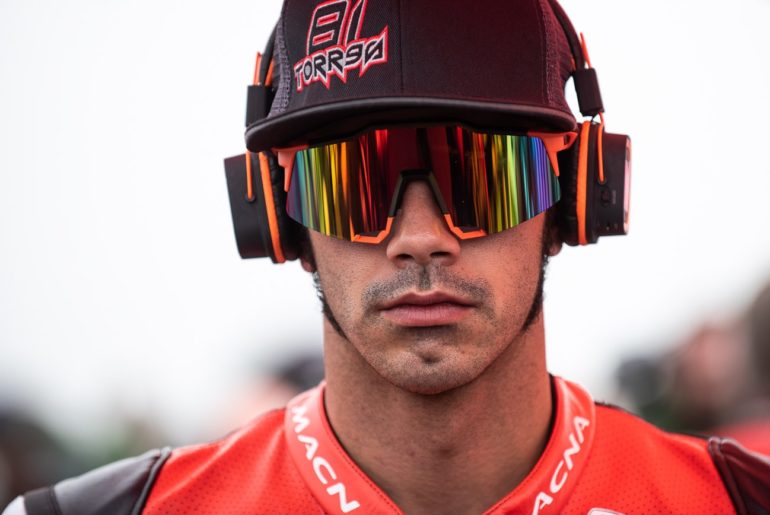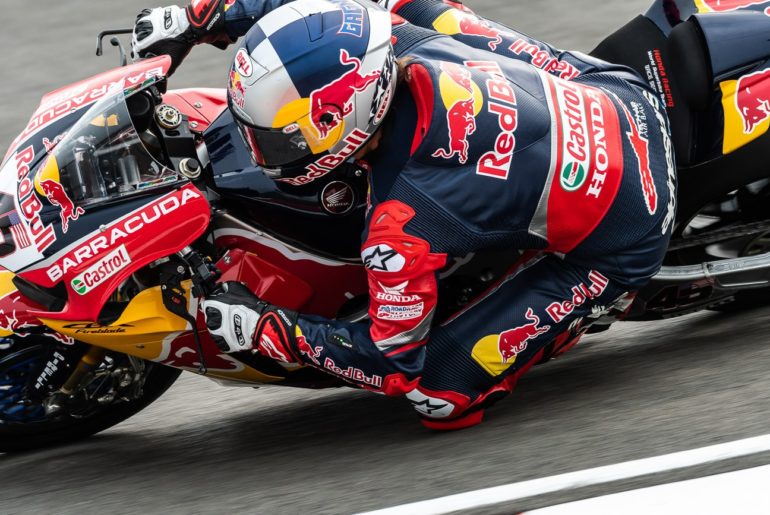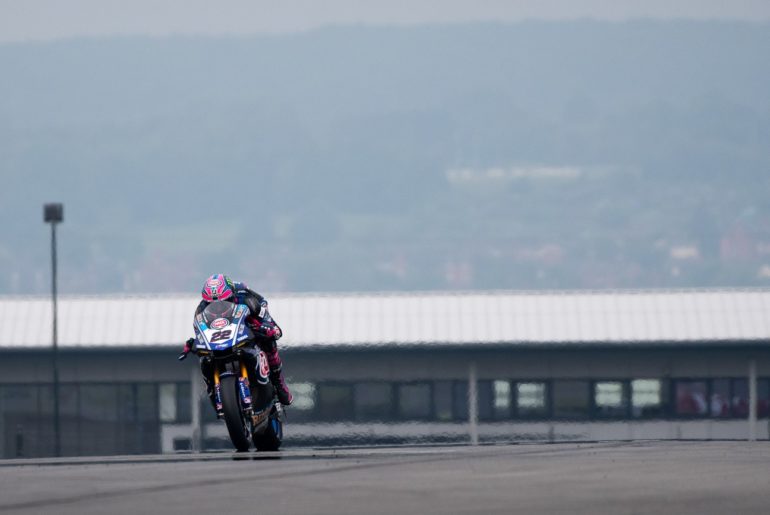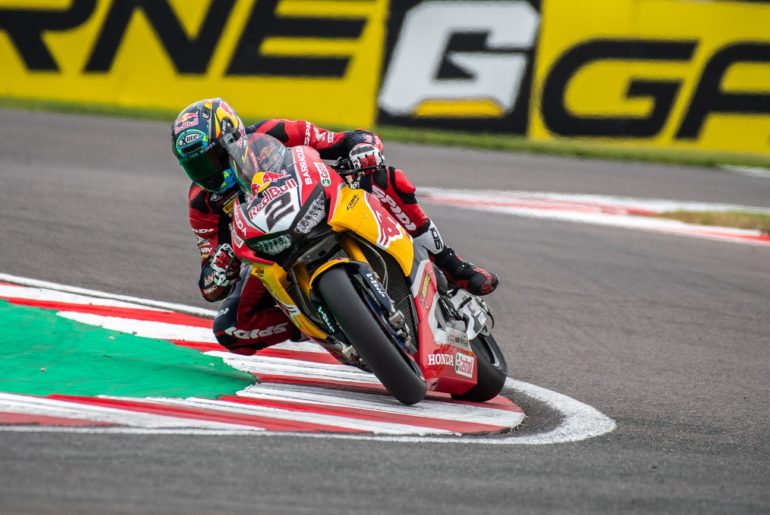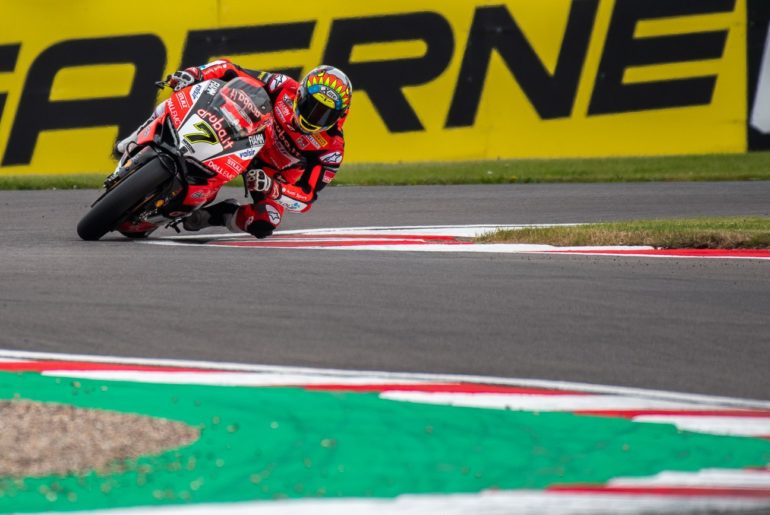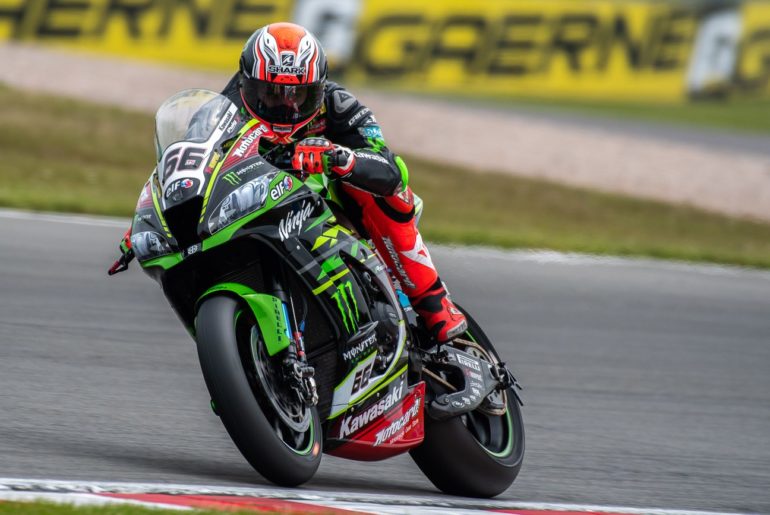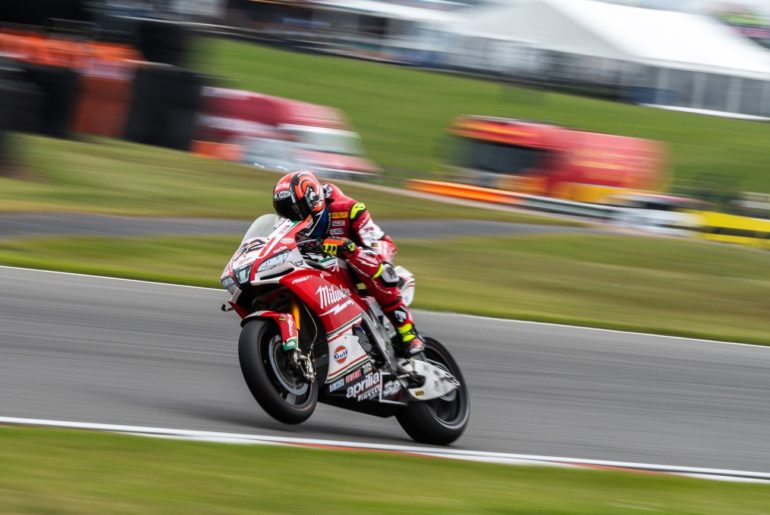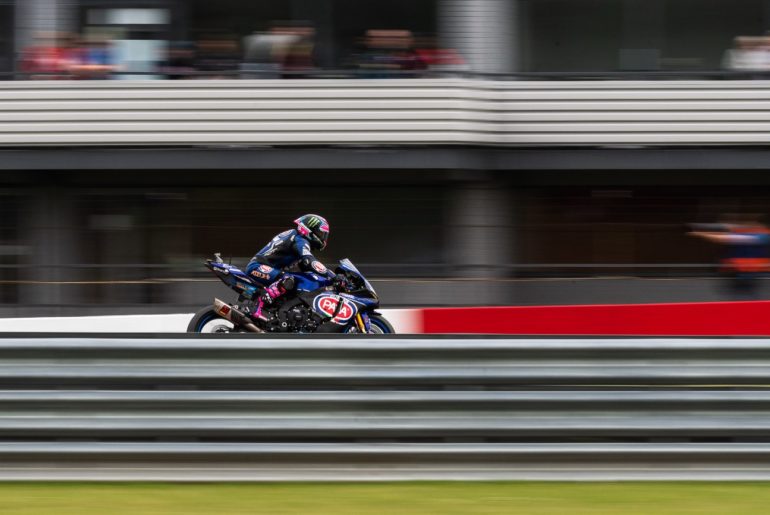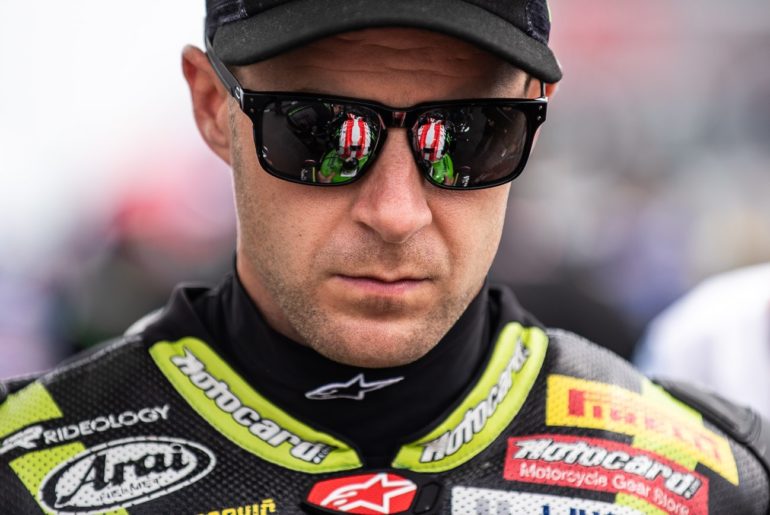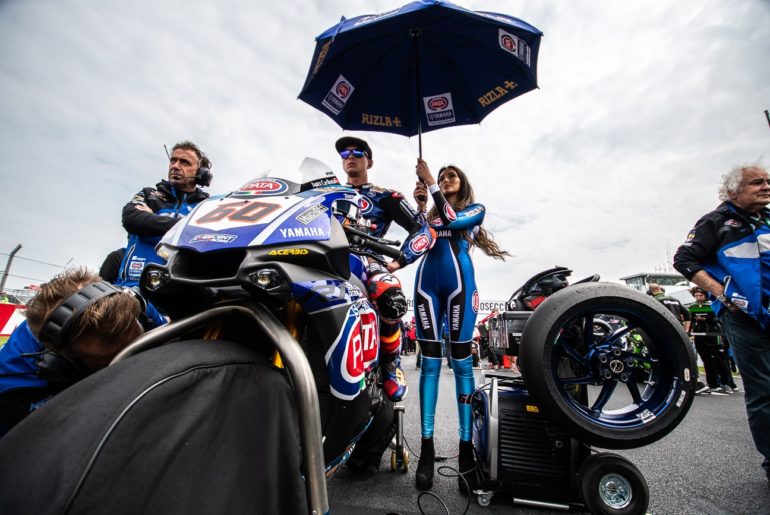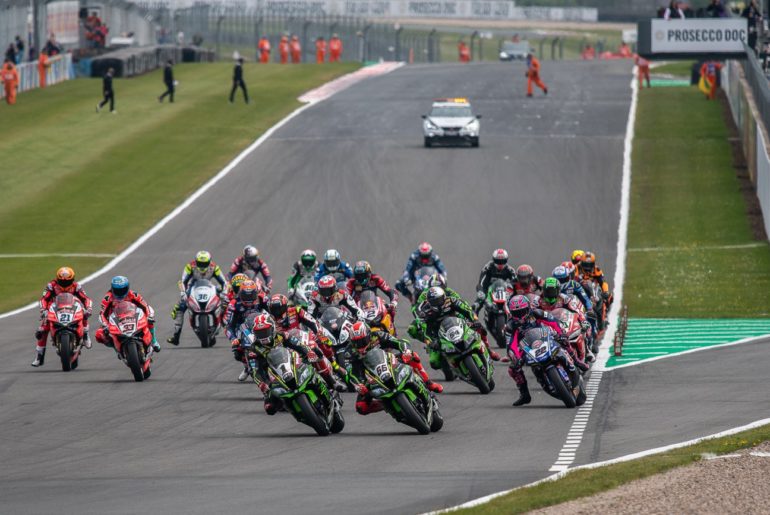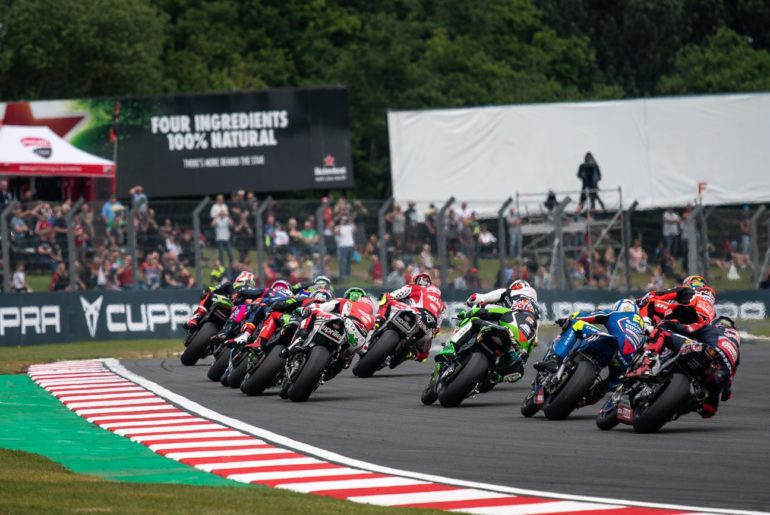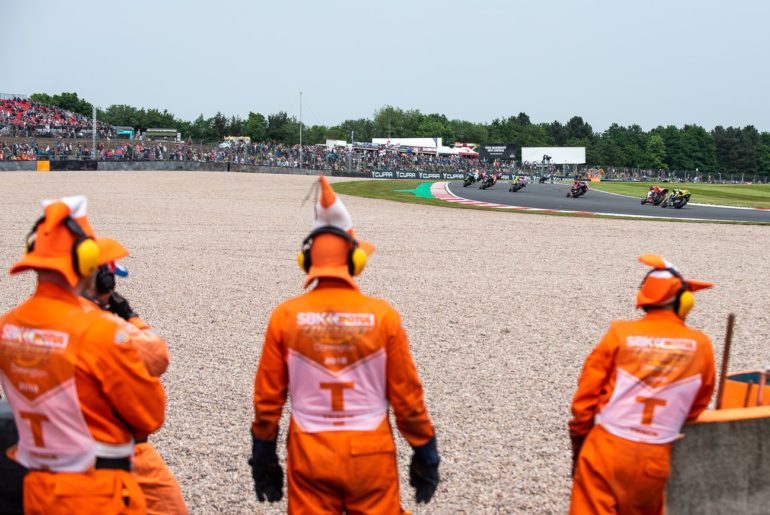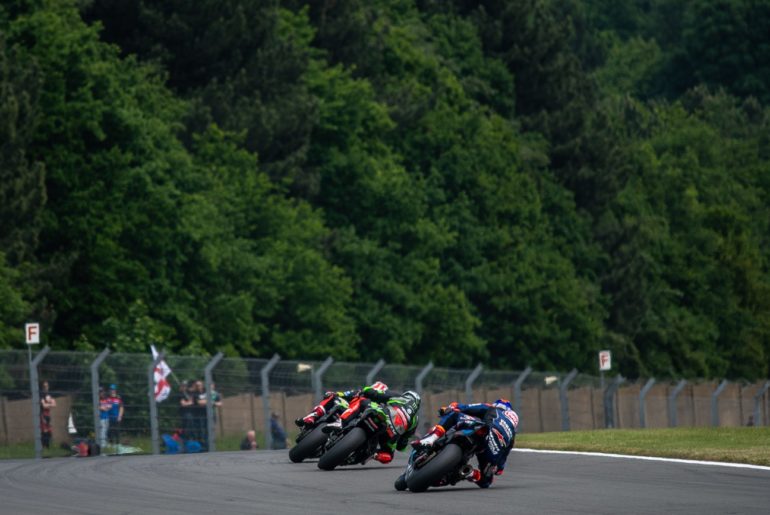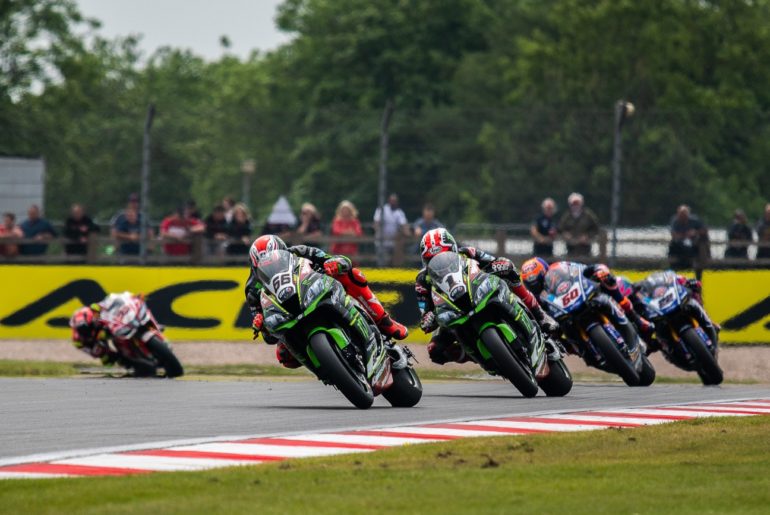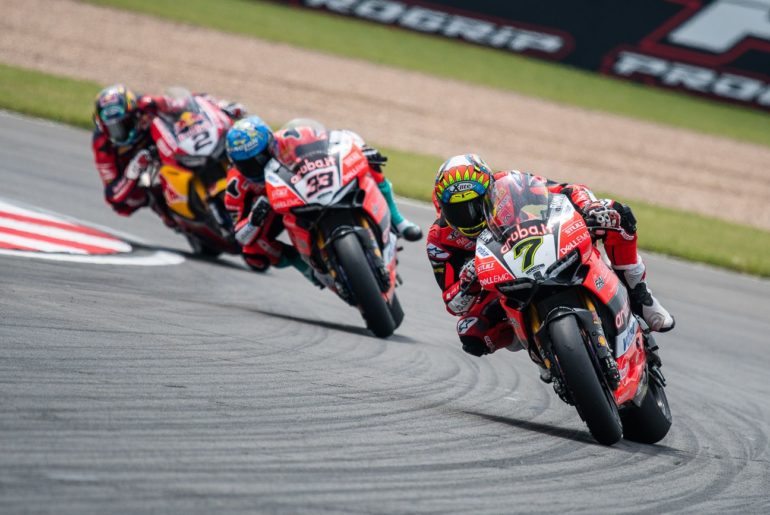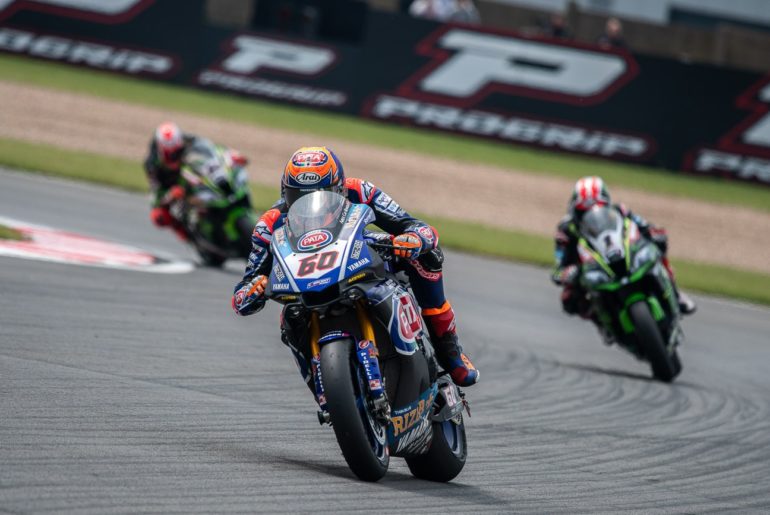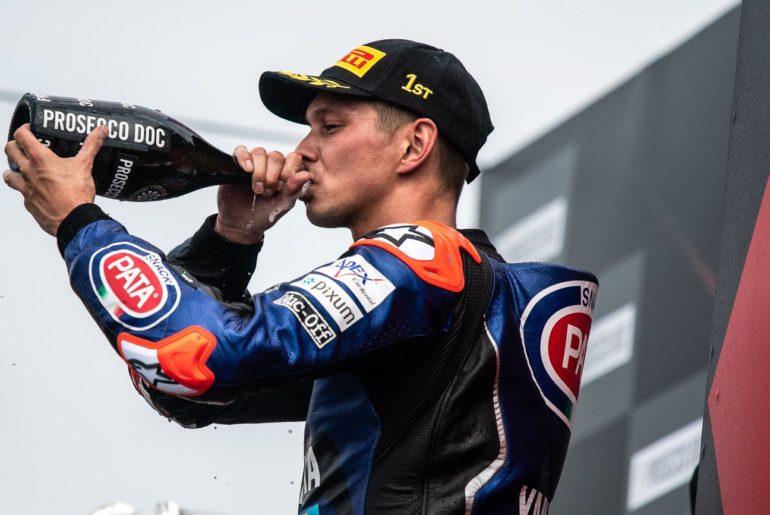The 2018 Isle of Man TT is underway and Asphalt & Rubber has you covered to get up to date with some of the biggest names at the Isle of Man TT.
The road racing capital of the world is rarely called a paradise, but it is hard to look past that word when the sun shines on this 200 square miles of rock in the Irish Sea.
This week the sun is certainly shining, and practice week has already been one to remember. Lap records look set to be shattered as this past winter is banished from memory by the burning sun.
The warm and dry conditions have allowed riders to clock up the miles already, and three days into practice, and just two days into Superbike running, 134mph laps have been the word on everyone’s lips.
Dean Harrison has set the pace with a 133.46mph lap on Tuesday, but for the Bradford native it was just the latest in a spate of fast laps.
Having warmed himself up with a series of outings in the British Superbike championship, Harrison is ready to fly on the island, as he chases his second TT win.
“My year is all about the TT,” said Harrison before the start of festivities. “This is the main race of the year, and it’s what I want to win. It’s what the team want to win. Everything is geared towards it, and my lifetime goal was to win the Senior.”
“I’ve been lucky to win a TT, but you want to win the big bike race. I’ve been trying to get as close as I can, but it’s about being able to do all six laps.”
“For this year, I’ve raced in BSB again and we’ve been able to use the same electronics there that I’ll use on the roads this year. It’s useful to get it set up there, and you can hang it out all and make sure everything’s working right.”
“I’ve actually loved racing on the short circuits. The BSB class is so competitive though! I jumped on a stock bike, and that really shows what you’ve improved on and how much progress you’re making with your riding.”
For Harrison, who learned his trade in the Irish national races, this year’s TT comes at the perfect time. At 29 years of age, he’s matured into one of the top riders on the roads, and with two big bike podiums at the recent Northwest 200, he has rounded into form perfectly.
“I had two podiums last year, and I was third in the Senior, but the goal is to win another TT. I’m looking forward to it. I think that some riders are ready to make the step up to fight for wins, but you’ve got to do your homework.”
“You have to do the work, do the laps, do the mileage, and just come year after year, and don’t rush the job.”
“A six-lap race is tough physically and mentally. In short circuit racing, it’s more physical than mental, but the TT is the opposite. It’s definitely a lot more mental compared to the short circuits. It’s physical too but the concentration you need is for so much longer.”
Harrison won’t be the only rider ready to make the step into a contender this year. While the Silocone Engineering Kawasaki rider is the name on everyone’s lips through the opening night’s of practice, there are plenty of other riders ready to step up.
Peter Hickman has ticked all the boxes in his formative years of road racing and the fourth fastest rider of all-time is ready to add his name to the list of winners.
“I’ve been able to win at all the other international races, and I’d love to win a TT,” said the always smiling Hickman. “Winning is the target, and to get a TT win would be great.”
“Last year we had a very strong year with podiums in every race, and we know that we have to build on that and try and get a win.”
“This year will be the first year that I ride the same bikes with the same team for two years in a row. That will be good and last year was the accumulation of all that hard work.”
“I’ve been able to build year-on-year with the TT. I came in as the fastest newcomer and even in difficult years, 2016 for example with the Kawasaki, I’ve still been fast. That year I set the fourth fastest time of all-time.”
“I think that everything will be fine for this year once we have some luck. The weather is important too, because it’s been nice so far and we’ve been able to get in a lot of miles early in the practice week.”
Hickman recently claimed his first North West 200 victory, and it’s clear that he understands the importance, history and lure of road racing. Since making the decision to race on the roads, he has turned into one of the hottest properties in British racing and a man in demand in the BSB paddock.
“The road races are all special because you only get once chance at them each year. The Northwest, TT, and the Ulster have so much history as well and that’s always cool. Road races are dangerous and thrilling and that’s what makes them so special.”
“I love being a rider that can race in BSB and the Roads and win in both disciplines.”
“I’m a short circuit rider, and have been able to win in British Superbikes, and I’m doing some World Endurance this year as well. When I look back to 2014, I was struggling to get a ride, so I decided that I’d try something different and come to race on the roads.”
“I wanted to see if I’d like it. It turns out that I love it, and I’m pretty good at it! I’ve never liked being called an all-rounder, because it implies I’m good at everything but great at nothing! I know that I’m a bit unique to be able to do both, and win at both and that’s the goal for this year again.”
If Hickman’s form holds, he’ll have to get used to being called an all-rounder.
Josh Brookes is another rider out to prove his mettle on the roads. The Australian’s talent and speed will never be in doubt, and as a former fastest-ever newcomer his ability to learn the track are also beyond question.
The Norton rider will go off at #11 this year, and will certainly have pressure on his shoulders given that he is the sole rider for the team.
For the 2015 British Superbike champion, the move to the roads made perfect sense and was one that he’s been thrilled to make.
“I love the TT. I can now remember clearer just now much of a disappointment it was when I wasn’t able to come back in 2015 and WorldSBK was my focus.”
“I came over that year to watch the races, and it really started to sink in that I’d rather be riding than watching. It’s such a great event and the TT suits my character, I’m a bit unpredictable, and I’ve always lived a little on the extreme and that’s the TT in a nutshell.”
“A fat wallet doesn’t get you the chance to ride at the TT, it’s an old school, raw, grass roots type of event.”
“When we get to the startline to me it feel like any other race but there’s a lot more nervous energy around the paddock. It’s not different to race here compared to short circuits.”
“I think that the people around short circuit racing feel like when you go out on the track that you’re safe, it’s almost like we don’t recognize or the general public at least, don’t recognize the dangers.”
“That’s why you don’t feel as much that nervous energy around the paddock at a short circuit race.”
“Here at the TT though it’s more recognized that there’s a danger. You carry a lot of that energy with you, even though you don’t want to do that.”
“It comes from other people that there’s something to be nervous about. Once you hop on your bike, and you set off all that nervous energy goes away. When you’re riding you choose when you brake, and you choose when you open the gas.”
“Here at the TT you start to brake when you don’t feel like you want to go any faster and you need to slow down. You don’t open the gas until it’s your moment to accelerate. It’s all your own choices and your own actions, so you don’t feel nervous when you’re riding the bike.”
While Brookes won’t have a teammate to compare himself with this year, he does have some targets in mind; a first TT podium.
Racing for Norton in the Superbike and Senior classes will make a podium a particular challenge, but his Yamaha R6 in the Supersport, and the Lightweight class ,could offer a genuine opportunity.
“I don’t set firm targets for the TT, but I do think about what’s realistic. I think that a podium is now possible for me, because I’m getting more experienced at the TT.”
“If it doesn’t happen, I won’t be disappointed, because I know that I’ll have ridden my best on the day while riding as safely as I can. The Norton is close to the front now too, but as you get nearer to the top it becomes harder to make big improvements with the bike.”
Brookes isn’t the only Australian chasing a podium; David Johnson is also in the hunt. The Australian has been able to finish fourth in the past, and the 11th fastest man of all-time is ready to set it up this year as he switches from Norton to the Shaun Muir Racing squad.
Jumping on a BMW is an easy way to make yourself a contender at the Isle of Man TT, but Johnson has certainly earned his island stripes. The move to the Gulf BMW certainly offers him a chance to be a contender this year and the goal is to finally crack the podium.
“We’ve been able to get some running in BSB to learn a bit about the bike, but we’ve had to turn all the good stuff off! All the electronics have been taken away from us so we could race, but it means that we’re not using the same specification as at the TT.”
“For the Northwest 200, we were be on the full spec. I’ve really enjoyed working with the team so far. They’re the best team I’ve ever ridden for. The good thing is that we’ve been able to get some track time before the roads season. That’s the only reason we raced in BSB at the start of the year.”
“It’s tough when you race in BSB, because I don’t like to see my name at the bottom of the times in any session, but we’re not racing in BSB to win.”
“It’s about building up for the TT. I feel really good on the bike. It’s a freaking animal with all the electronics taken off, but it’ll pay off well to go fast in the TT.”
“The BMW is a proven package. I’m glad we’ve been able to some BSB rounds just to find some things on the bike that I wouldn’t have found otherwise. We didn’t run our full electronics a BSB and still had to put on the correct swingarm and some other stuff for the roads.”
“The difference between BSB and the roads is quite big, and we’ll use the standard swingarm at the TT because it’s stronger. It’s mostly a little bit of fine-tuning to the bike and the riders aids. Once all that’s ready, it’s about riding in anger and trying to do a lap time.”
Over the last two years “Davo” has certainly been able to put himself in the frame and develop the Norton. The British machine was a running joke within the paddock at times prior to Johnson’s arrival, and last year both riders were able to lap at over 130mph.
For the coming TT festival, Johnson has been doing all he can to get ready for the races. Finding time in any saddle available has been his goal and racing at the Phillip Island Classic, instructing in Australia and Spain, and racing in BSB have all been valuable but he knows that his real work is about to begin.
“Over the off-season I was doing a lot of instructing and I raced at the Philip Island Classic as well. I’ve done a fair bit of riding, but nothing like the TT!”
“It freaking hurts running in BSB without the electronics, and it it does make it hard, but I’ve had to keep in mind that the goal of racing in Britain was just to get some track time and bike fitness before the Northwest and the TT.”
Michael Dunlop’s switch to the Tyco squad was one of the most talked about decisions in recent years of road racing, and his choice will see him once again start Race Week as the firm favourite.
During the opening nights of practice, he suffered some niggling issues, but his speed is as incredible as ever. Second fastest in practice after the opening two nights of Superbike running, he will be at the front when it matters this year once again.
His long-time rival, Ian Hutchinson, is much trickier to judge. The Englishman has more TT wins than any other active rider, but he’ll face a struggle to prove his fitness and set fast times.
His switch to Honda was one that would always prove challenging, but having only recently been able to remove the cage on his leg following last year’s TT crash he’s facing an uphill task this year.
Hutchy has overcome a lot in the past, but switching bikes and recovering from such a serious smash are likely to be too far beyond even the Bringley Bullet.
He has said that the target is just to get through the fortnight and see how fast he can go. The Honda Fireblade is ready to be a contender this year, but now the question turns to how much bike fitness the 38-year-old has.
There are a lot of questions still to be answered ahead of Saturday’s opening race of the year, but one thing is certain; it’ll be a special fortnight at a very special place.
Photo: © 2012 Daniel Lo / Corner Speed Photo – All Rights Reserved
This Isle of Man TT story is made possible by our A&R Pro members. If you enjoy our coverage of the TT on Asphalt & Rubber, you should consider supporting this content by signing up for A&R Pro.
Be sure to follow all of our 2018 Isle of Man TT racing coverage this fortnight.

